Strategic Change in Organizations: An Analytical Report (Course Name)
VerifiedAdded on 2021/04/24
|5
|1029
|52
Report
AI Summary
This analytical report examines various models of strategic change within organizations. It explores the Lewin’s Model, Action Research Model, and the Positive Model, detailing their processes and applications. The report emphasizes the relevance of these models in facilitating organizational success, addressing rapid environmental changes, and supporting decision-making. It also assesses the value of strategic intervention, highlighting how it enhances competitiveness, fosters common processes, and aligns organizational priorities. The report includes a reference list for further study. This document is a valuable resource for students seeking to understand strategic change and its impact on organizational development, available on Desklib.
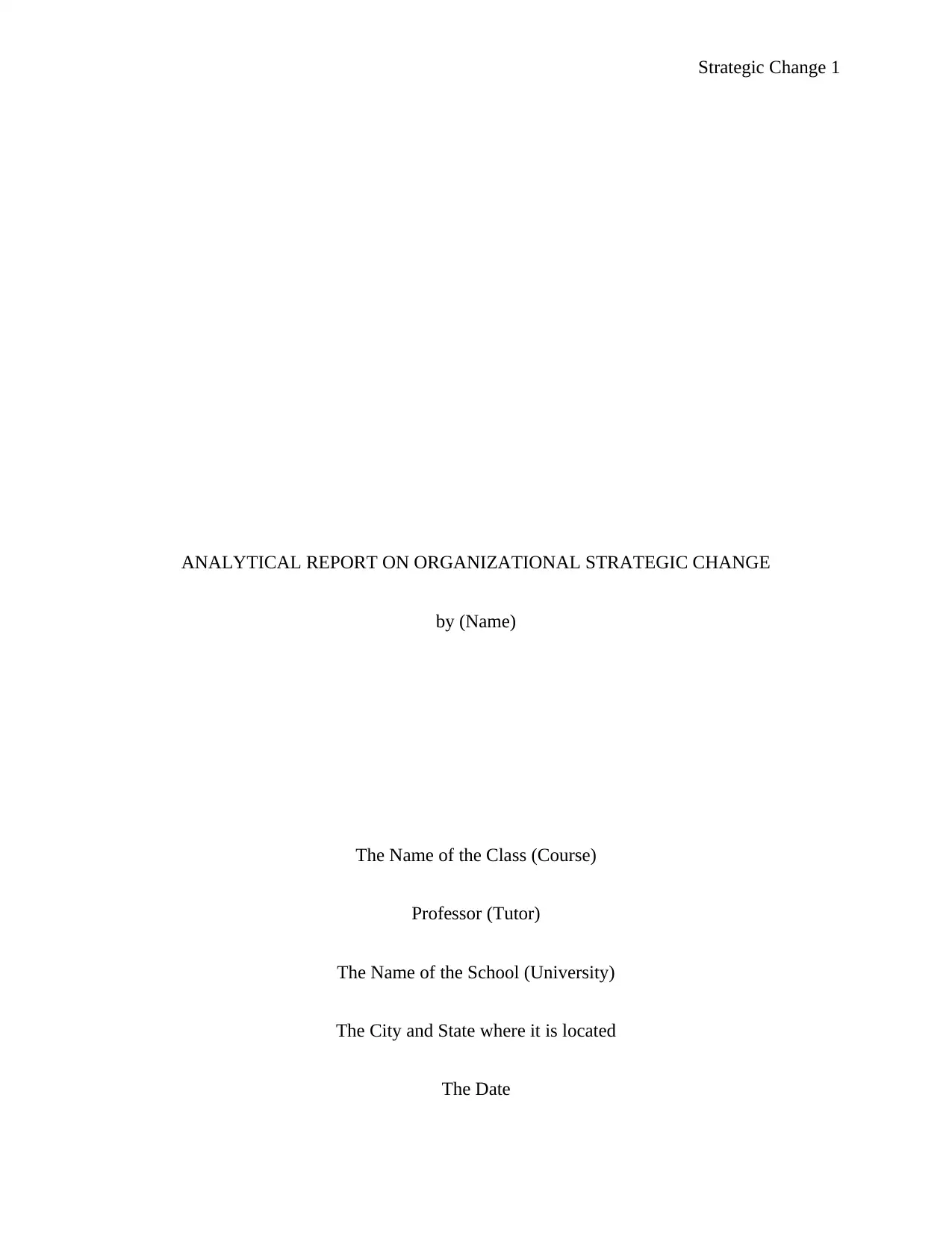
Strategic Change 1
ANALYTICAL REPORT ON ORGANIZATIONAL STRATEGIC CHANGE
by (Name)
The Name of the Class (Course)
Professor (Tutor)
The Name of the School (University)
The City and State where it is located
The Date
ANALYTICAL REPORT ON ORGANIZATIONAL STRATEGIC CHANGE
by (Name)
The Name of the Class (Course)
Professor (Tutor)
The Name of the School (University)
The City and State where it is located
The Date
Paraphrase This Document
Need a fresh take? Get an instant paraphrase of this document with our AI Paraphraser
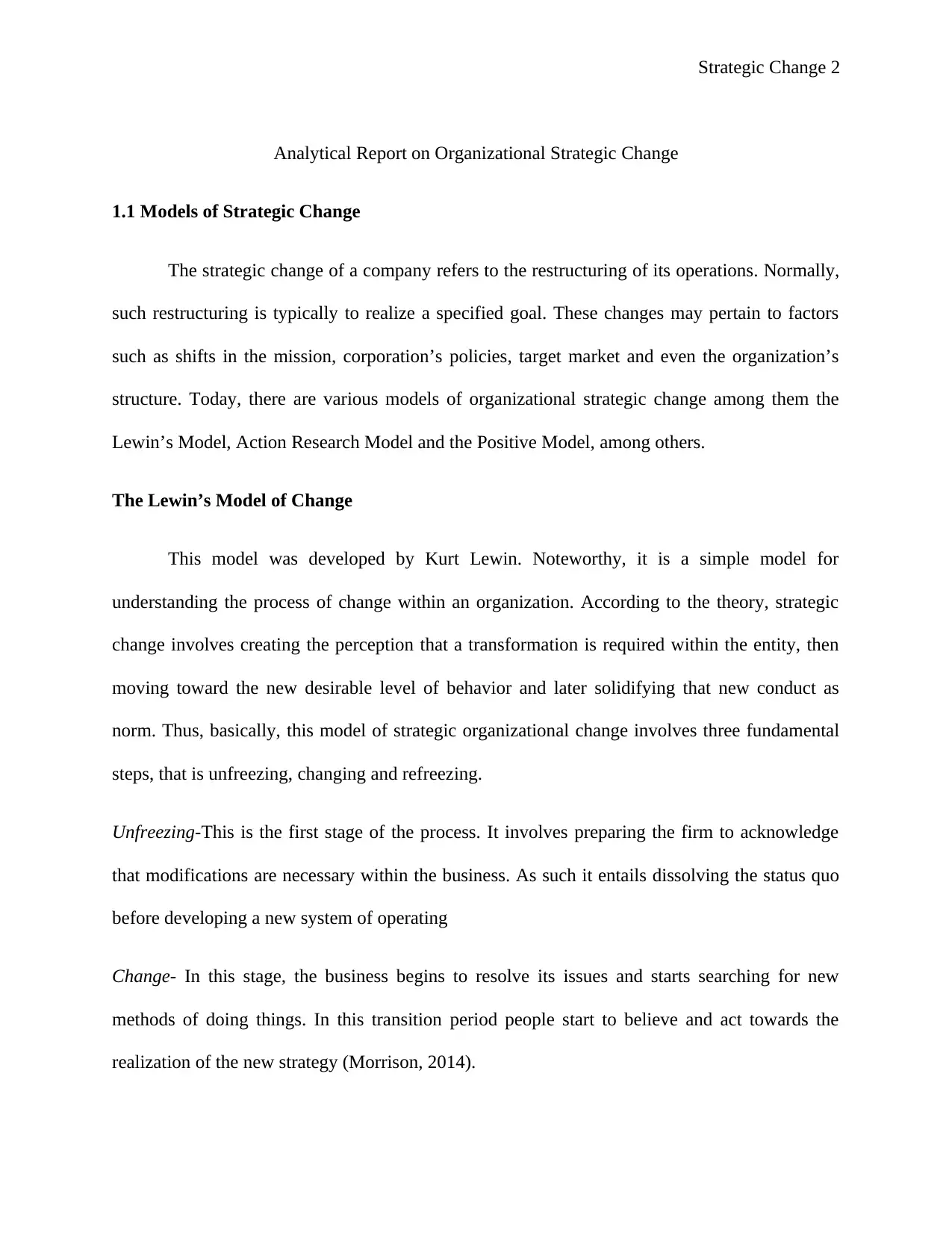
Strategic Change 2
Analytical Report on Organizational Strategic Change
1.1 Models of Strategic Change
The strategic change of a company refers to the restructuring of its operations. Normally,
such restructuring is typically to realize a specified goal. These changes may pertain to factors
such as shifts in the mission, corporation’s policies, target market and even the organization’s
structure. Today, there are various models of organizational strategic change among them the
Lewin’s Model, Action Research Model and the Positive Model, among others.
The Lewin’s Model of Change
This model was developed by Kurt Lewin. Noteworthy, it is a simple model for
understanding the process of change within an organization. According to the theory, strategic
change involves creating the perception that a transformation is required within the entity, then
moving toward the new desirable level of behavior and later solidifying that new conduct as
norm. Thus, basically, this model of strategic organizational change involves three fundamental
steps, that is unfreezing, changing and refreezing.
Unfreezing-This is the first stage of the process. It involves preparing the firm to acknowledge
that modifications are necessary within the business. As such it entails dissolving the status quo
before developing a new system of operating
Change- In this stage, the business begins to resolve its issues and starts searching for new
methods of doing things. In this transition period people start to believe and act towards the
realization of the new strategy (Morrison, 2014).
Analytical Report on Organizational Strategic Change
1.1 Models of Strategic Change
The strategic change of a company refers to the restructuring of its operations. Normally,
such restructuring is typically to realize a specified goal. These changes may pertain to factors
such as shifts in the mission, corporation’s policies, target market and even the organization’s
structure. Today, there are various models of organizational strategic change among them the
Lewin’s Model, Action Research Model and the Positive Model, among others.
The Lewin’s Model of Change
This model was developed by Kurt Lewin. Noteworthy, it is a simple model for
understanding the process of change within an organization. According to the theory, strategic
change involves creating the perception that a transformation is required within the entity, then
moving toward the new desirable level of behavior and later solidifying that new conduct as
norm. Thus, basically, this model of strategic organizational change involves three fundamental
steps, that is unfreezing, changing and refreezing.
Unfreezing-This is the first stage of the process. It involves preparing the firm to acknowledge
that modifications are necessary within the business. As such it entails dissolving the status quo
before developing a new system of operating
Change- In this stage, the business begins to resolve its issues and starts searching for new
methods of doing things. In this transition period people start to believe and act towards the
realization of the new strategy (Morrison, 2014).
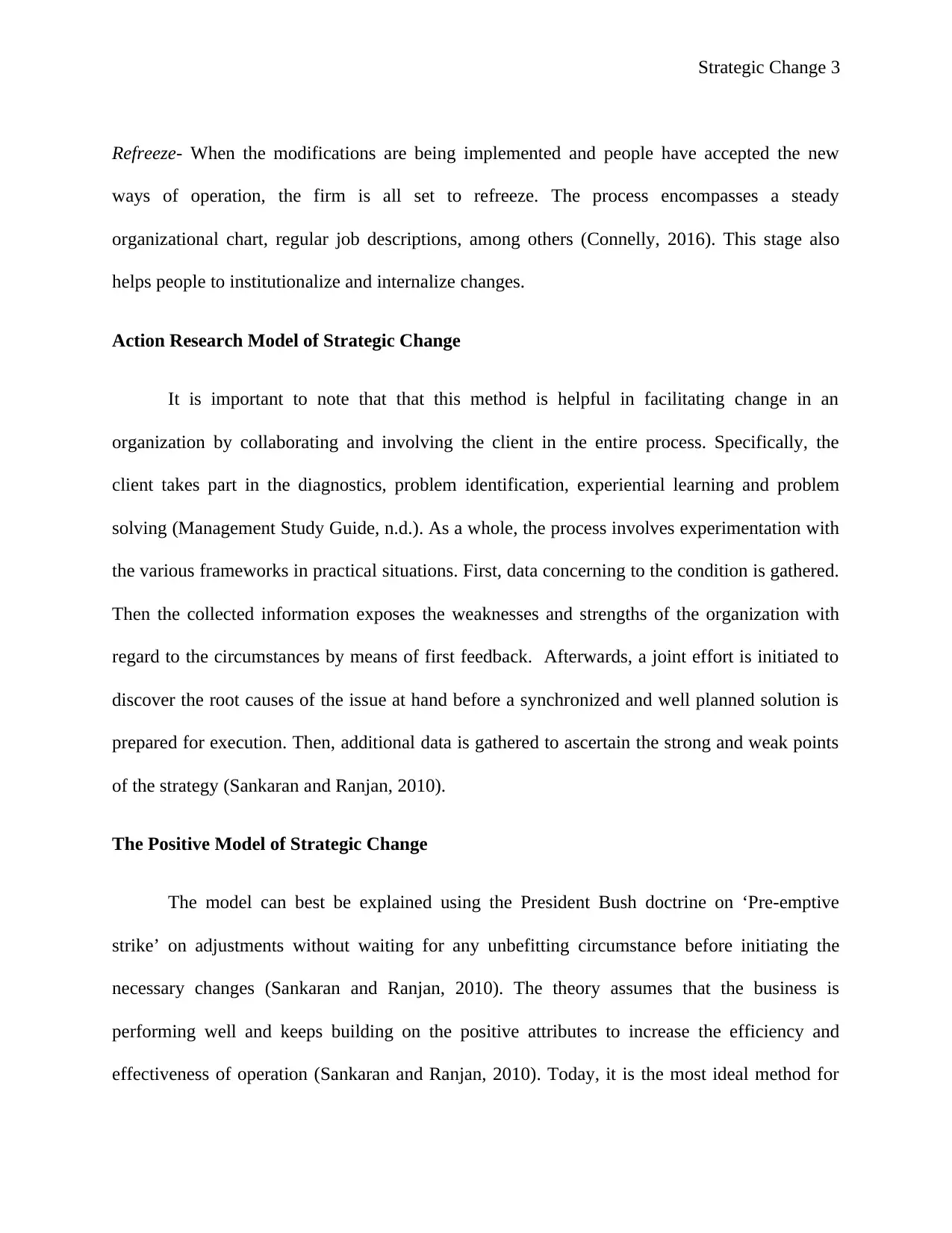
Strategic Change 3
Refreeze- When the modifications are being implemented and people have accepted the new
ways of operation, the firm is all set to refreeze. The process encompasses a steady
organizational chart, regular job descriptions, among others (Connelly, 2016). This stage also
helps people to institutionalize and internalize changes.
Action Research Model of Strategic Change
It is important to note that that this method is helpful in facilitating change in an
organization by collaborating and involving the client in the entire process. Specifically, the
client takes part in the diagnostics, problem identification, experiential learning and problem
solving (Management Study Guide, n.d.). As a whole, the process involves experimentation with
the various frameworks in practical situations. First, data concerning to the condition is gathered.
Then the collected information exposes the weaknesses and strengths of the organization with
regard to the circumstances by means of first feedback. Afterwards, a joint effort is initiated to
discover the root causes of the issue at hand before a synchronized and well planned solution is
prepared for execution. Then, additional data is gathered to ascertain the strong and weak points
of the strategy (Sankaran and Ranjan, 2010).
The Positive Model of Strategic Change
The model can best be explained using the President Bush doctrine on ‘Pre-emptive
strike’ on adjustments without waiting for any unbefitting circumstance before initiating the
necessary changes (Sankaran and Ranjan, 2010). The theory assumes that the business is
performing well and keeps building on the positive attributes to increase the efficiency and
effectiveness of operation (Sankaran and Ranjan, 2010). Today, it is the most ideal method for
Refreeze- When the modifications are being implemented and people have accepted the new
ways of operation, the firm is all set to refreeze. The process encompasses a steady
organizational chart, regular job descriptions, among others (Connelly, 2016). This stage also
helps people to institutionalize and internalize changes.
Action Research Model of Strategic Change
It is important to note that that this method is helpful in facilitating change in an
organization by collaborating and involving the client in the entire process. Specifically, the
client takes part in the diagnostics, problem identification, experiential learning and problem
solving (Management Study Guide, n.d.). As a whole, the process involves experimentation with
the various frameworks in practical situations. First, data concerning to the condition is gathered.
Then the collected information exposes the weaknesses and strengths of the organization with
regard to the circumstances by means of first feedback. Afterwards, a joint effort is initiated to
discover the root causes of the issue at hand before a synchronized and well planned solution is
prepared for execution. Then, additional data is gathered to ascertain the strong and weak points
of the strategy (Sankaran and Ranjan, 2010).
The Positive Model of Strategic Change
The model can best be explained using the President Bush doctrine on ‘Pre-emptive
strike’ on adjustments without waiting for any unbefitting circumstance before initiating the
necessary changes (Sankaran and Ranjan, 2010). The theory assumes that the business is
performing well and keeps building on the positive attributes to increase the efficiency and
effectiveness of operation (Sankaran and Ranjan, 2010). Today, it is the most ideal method for
⊘ This is a preview!⊘
Do you want full access?
Subscribe today to unlock all pages.

Trusted by 1+ million students worldwide
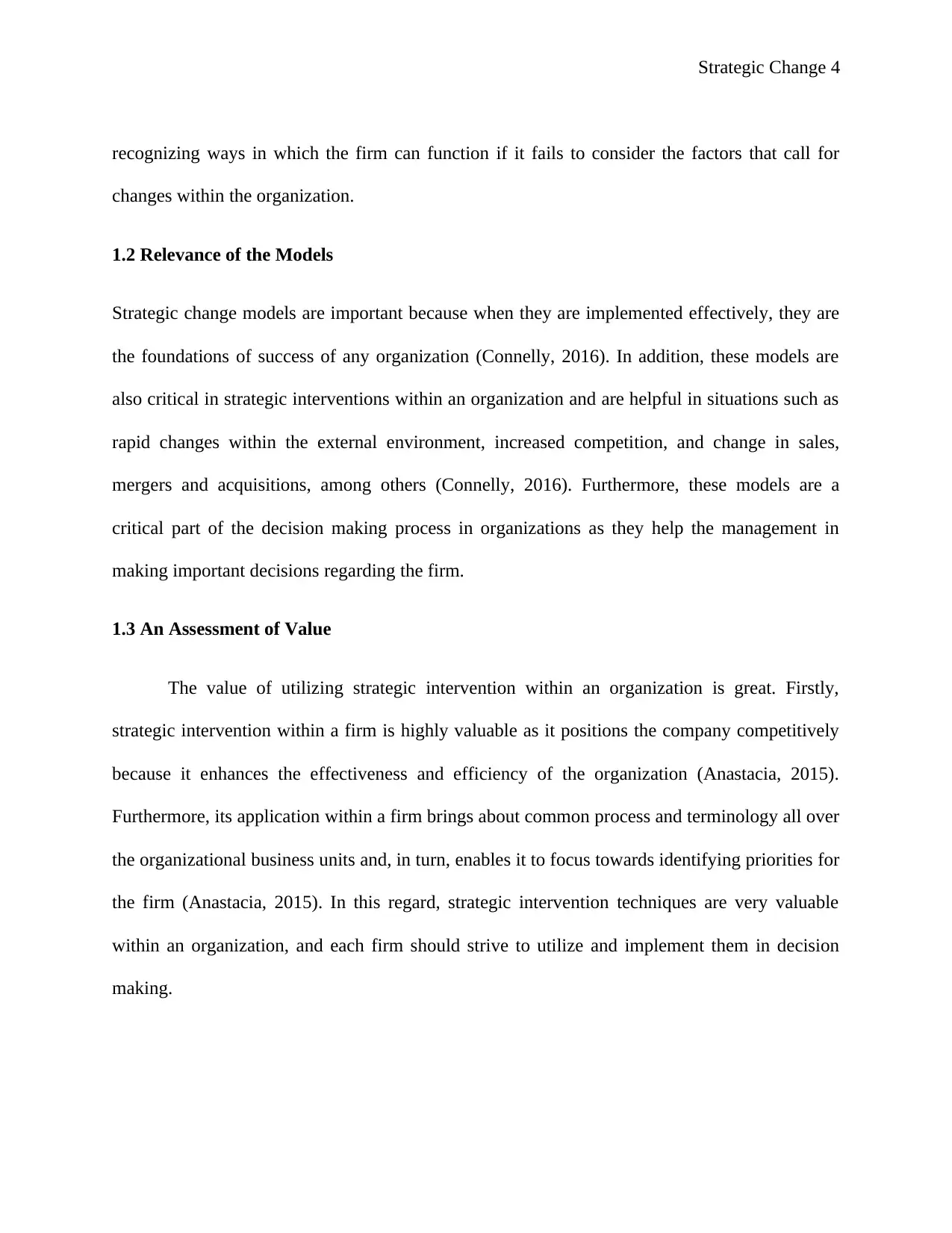
Strategic Change 4
recognizing ways in which the firm can function if it fails to consider the factors that call for
changes within the organization.
1.2 Relevance of the Models
Strategic change models are important because when they are implemented effectively, they are
the foundations of success of any organization (Connelly, 2016). In addition, these models are
also critical in strategic interventions within an organization and are helpful in situations such as
rapid changes within the external environment, increased competition, and change in sales,
mergers and acquisitions, among others (Connelly, 2016). Furthermore, these models are a
critical part of the decision making process in organizations as they help the management in
making important decisions regarding the firm.
1.3 An Assessment of Value
The value of utilizing strategic intervention within an organization is great. Firstly,
strategic intervention within a firm is highly valuable as it positions the company competitively
because it enhances the effectiveness and efficiency of the organization (Anastacia, 2015).
Furthermore, its application within a firm brings about common process and terminology all over
the organizational business units and, in turn, enables it to focus towards identifying priorities for
the firm (Anastacia, 2015). In this regard, strategic intervention techniques are very valuable
within an organization, and each firm should strive to utilize and implement them in decision
making.
recognizing ways in which the firm can function if it fails to consider the factors that call for
changes within the organization.
1.2 Relevance of the Models
Strategic change models are important because when they are implemented effectively, they are
the foundations of success of any organization (Connelly, 2016). In addition, these models are
also critical in strategic interventions within an organization and are helpful in situations such as
rapid changes within the external environment, increased competition, and change in sales,
mergers and acquisitions, among others (Connelly, 2016). Furthermore, these models are a
critical part of the decision making process in organizations as they help the management in
making important decisions regarding the firm.
1.3 An Assessment of Value
The value of utilizing strategic intervention within an organization is great. Firstly,
strategic intervention within a firm is highly valuable as it positions the company competitively
because it enhances the effectiveness and efficiency of the organization (Anastacia, 2015).
Furthermore, its application within a firm brings about common process and terminology all over
the organizational business units and, in turn, enables it to focus towards identifying priorities for
the firm (Anastacia, 2015). In this regard, strategic intervention techniques are very valuable
within an organization, and each firm should strive to utilize and implement them in decision
making.
Paraphrase This Document
Need a fresh take? Get an instant paraphrase of this document with our AI Paraphraser
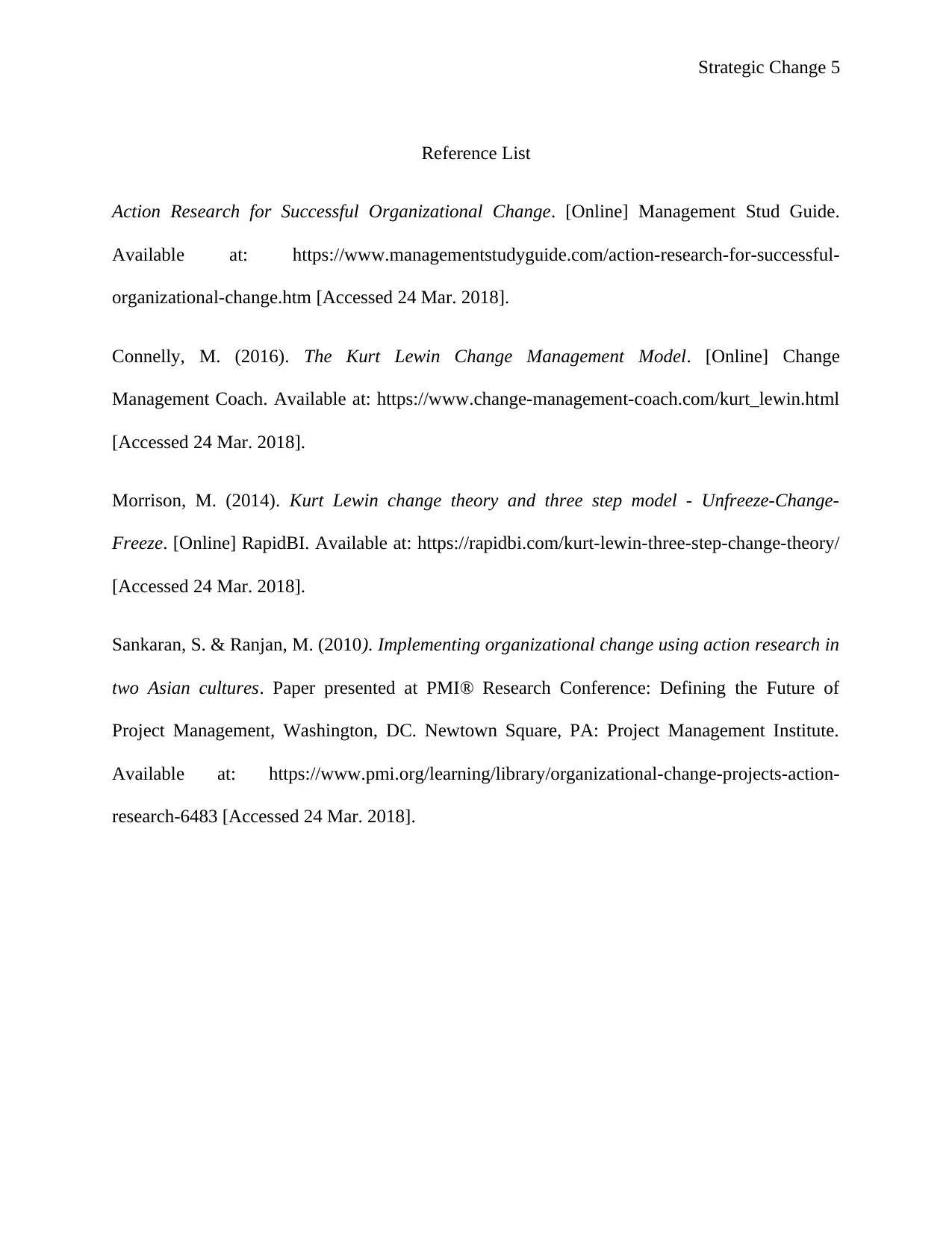
Strategic Change 5
Reference List
Action Research for Successful Organizational Change. [Online] Management Stud Guide.
Available at: https://www.managementstudyguide.com/action-research-for-successful-
organizational-change.htm [Accessed 24 Mar. 2018].
Connelly, M. (2016). The Kurt Lewin Change Management Model. [Online] Change
Management Coach. Available at: https://www.change-management-coach.com/kurt_lewin.html
[Accessed 24 Mar. 2018].
Morrison, M. (2014). Kurt Lewin change theory and three step model - Unfreeze-Change-
Freeze. [Online] RapidBI. Available at: https://rapidbi.com/kurt-lewin-three-step-change-theory/
[Accessed 24 Mar. 2018].
Sankaran, S. & Ranjan, M. (2010). Implementing organizational change using action research in
two Asian cultures. Paper presented at PMI® Research Conference: Defining the Future of
Project Management, Washington, DC. Newtown Square, PA: Project Management Institute.
Available at: https://www.pmi.org/learning/library/organizational-change-projects-action-
research-6483 [Accessed 24 Mar. 2018].
Reference List
Action Research for Successful Organizational Change. [Online] Management Stud Guide.
Available at: https://www.managementstudyguide.com/action-research-for-successful-
organizational-change.htm [Accessed 24 Mar. 2018].
Connelly, M. (2016). The Kurt Lewin Change Management Model. [Online] Change
Management Coach. Available at: https://www.change-management-coach.com/kurt_lewin.html
[Accessed 24 Mar. 2018].
Morrison, M. (2014). Kurt Lewin change theory and three step model - Unfreeze-Change-
Freeze. [Online] RapidBI. Available at: https://rapidbi.com/kurt-lewin-three-step-change-theory/
[Accessed 24 Mar. 2018].
Sankaran, S. & Ranjan, M. (2010). Implementing organizational change using action research in
two Asian cultures. Paper presented at PMI® Research Conference: Defining the Future of
Project Management, Washington, DC. Newtown Square, PA: Project Management Institute.
Available at: https://www.pmi.org/learning/library/organizational-change-projects-action-
research-6483 [Accessed 24 Mar. 2018].
1 out of 5
Related Documents
Your All-in-One AI-Powered Toolkit for Academic Success.
+13062052269
info@desklib.com
Available 24*7 on WhatsApp / Email
![[object Object]](/_next/static/media/star-bottom.7253800d.svg)
Unlock your academic potential
Copyright © 2020–2025 A2Z Services. All Rights Reserved. Developed and managed by ZUCOL.





